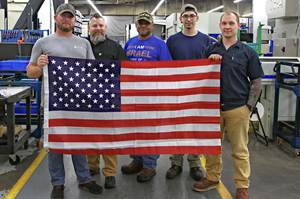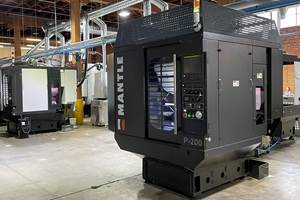Testing Job Applicants for CNC Programming Proficiency
The best way to confirm prior experience of new CNC programmers and operators is with formal assessments of knowledge and ability.
Share





As manufacturing continues to rebound in the United States, companies are finding it more and more difficult to find and hire qualified CNC programmers and operators. Your obvious goal during the hiring process is to secure the best applicant from a pool of available candidates, at the wage your company is willing to pay.
If you have not done so already, you should create an interview process for use in hiring people to program, set up and run your CNC machines. This will ensure fairness to the applicants while keeping the process logical and consistent. There are countless online resources that can help you develop such a procedure, but there are several areas in particular that you will want to address.
A good hiring process will assess applicant attributes that include dependability, motivation, aptitude and proficiency. The first three are rather subjective qualities and difficult to accurately evaluate during a short interview. There are as many techniques to evaluate these qualities as there are applicants. Again, many online resources offer suggestions that should help.
Proficiency, on the other hand, should be relatively easy to assess. It is simply a person’s current knowledge and ability in a field of endeavor. Frankly speaking, however, proficiency is not the most important of the attributes. I would rate it well after the applicant’s eagerness (motivation) and ability to learn (aptitude). Additionally, you should be prepared for how to evaluate applicants who freely admit to having no previous experience performing required tasks, yet score well in other areas.
When an applicant does claim to have experience, you must confirm this claim. You must provide some way for him or her to demonstrate his or her knowledge and ability level. If you fully understand the required tasks, you may be able to assess an applicant’s experience level by simply asking a few pertinent questions and gauging the quality of his or her answers.
If you do not fully understand the tasks required for your open position, you will need some help. Managers and lead workers in the area/department that is looking to hire should be able to come up with a variety of real-world challenges that its workers regularly face.
How do you properly assess applicants?
I recommend combining physical tasks with a test to gauge an applicant’s proficiency. The physical tasks should parallel methods your staff is currently using, and examples include:
- Use of variable and fixed measuring tools like micrometers, calipers and go/no-go gages.
- Use of common hand tools.
- Use of deburring tools.
- Use of applicable computer programs.
The test could be handwritten or computer-generated. It should be developed by or with the help of managers in the department that needs the new staff. Be careful not to include company-specific terminology or methods. Doing so may cause an applicant with good experience to score poorly simply because he or she does not understand your company lingo.
We offer a proficiency test that you can use as a starting point for your own testing. Find the related files at cncci.com/pdf/CNC_Prof_Test.zip that you can easily modify to suit your purposes. Our test is divided into three sections—general, machining center and turning center—and includes a series of multiple-choice and true/false questions aimed at CNC setup workers and operators. Simply use test results to gauge a candidate’s current proficiency level. If an applicant scores 90 percent, for instance, you can be about 90 percent sure that applicant has the experience he or she claims to have.
Note that these physical tasks or tests should be administered only when an applicant claims to have experience. They will be of no value in evaluating an applicant who freely admits to not having such experience.
Related Content
Addressing the Manufacturing Labor Shortage Needs to Start Here
Student-run businesses focused on technical training for the trades are taking root across the U.S. Can we — should we — leverage their regional successes into a nationwide platform?
Read MoreFinding Skilled Labor Through Partnerships and Benefits
To combat the skilled labor shortage, this Top Shops honoree turned to partnerships and unique benefits to attract talented workers.
Read MoreShop Tour Video: You've Never Seen a Manufacturing Facility Like This
In the latest installment of our “View From My Shop” series, explore Marathon Precision’s multi-process approach to manufacturing, where blacksmiths and hand-forged dies meet state-of-the-art CNC machining. Discover how restoring classic muscle cars and building custom art projects creates a dynamic shop culture — and draws top talent to this unique and innovative metalworking facility.
Read MoreIn Moldmaking, Mantle Process Addresses Lead Time and Talent Pool
A new process delivered through what looks like a standard machining center promises to streamline machining of injection mold cores and cavities and even answer the declining availability of toolmakers.
Read MoreRead Next
AMRs Are Moving Into Manufacturing: 4 Considerations for Implementation
AMRs can provide a flexible, easy-to-use automation platform so long as manufacturers choose a suitable task and prepare their facilities.
Read MoreMachine Shop MBA
Making Chips and 91ÊÓƵÍøÕ¾ÎÛ are teaming up for a new podcast series called Machine Shop MBA—designed to help manufacturers measure their success against the industry’s best. Through the lens of the Top Shops benchmarking program, the series explores the KPIs that set high-performing shops apart, from machine utilization and first-pass yield to employee engagement and revenue per employee.
Read MoreLast Chance! 2025 Top Shops Benchmarking Survey Still Open Through April 30
Don’t miss out! 91ÊÓƵÍøÕ¾ÎÛ's Top Shops Benchmarking Survey is still open — but not for long. This is your last chance to a receive free, customized benchmarking report that includes actionable feedback across several shopfloor and business metrics.
Read More.jpg;width=70;height=70;mode=crop)






















